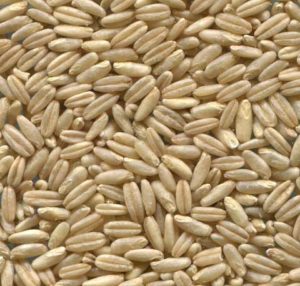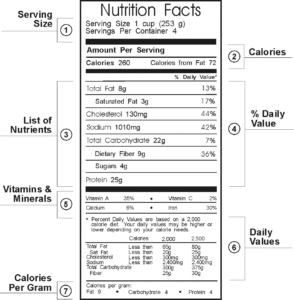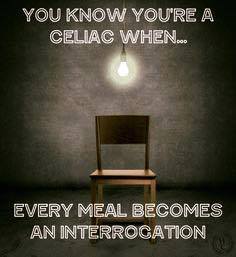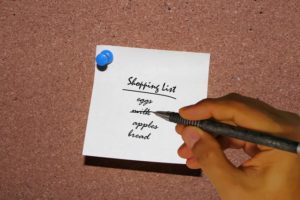You have just been diagnosed with celiac disease. Now what?!
Here are some basics to help you navigate this often overwhelming process:
- Cut out gluten
- Go through your pantry and recipes
- Learn about kitchen safety
- Education
- Learn how to read labels
- Learn how to eat out safely
- Testing of other family members
-
Cut out the gluten
The most important thing you can do after diagnosis is to cut gluten from your diet. Gluten= wheat, rye, barley and oats. This includes derivatives of wheat: graham, durum, emmer, spelt, kamut, khorasan wheat and einkom. Triticale is another cross-breed of wheat and rye.
 Oats
Oats
Let’s discuss oats for a minute. Oats are one of the most cross contaminated grains. They are often grown in the same fields that wheat has been grown in and milled in the same places. So, that’s problem # 1. Problem # 2 is that the oat protein, avenin, is really close to the gluten protein and not everyone who has celiac or is gluten intolerant can handle the oat protein. (I would say oats are the most controversial grain out there.) I read Dr. Rodney Ford’s study on this and he says, having a bad reaction to oats is often because of the cross contamination.
With that being said, the gut needs to have time to heal and cutting oats out of the diet for the first year, after diagnosis is a really good idea. Oats are really hard on the gut. The recommendation I have heard is: to cut oats out for the first year and then if you feel like you are healthy and on track, slowly add oats back into your diet. This is done by slowly adding ¼ a cup a week, paying close attention to how you feel and working your way up to 1 cup a week. If you are in your first year of gf avoid the cereals that are splashed with gf labeling, but contain oat flour. Please, give your gut and body time to heal. (Many gluten free groups don’t consider Cheerios to be gluten free. In Canada they cannot put gluten free on Cheerios!)
If you decide to add oats back into your diet make sure you use oats that follow a purity protocol. You can find out more about the purity protocol for oats at Gluten Free Watchdog, LLC. Oats have been controversial, but with research things continue to change and to be updated.
*** Gluten free grains: there are more gluten free grains than you are probably aware of! I was so surprised to see the long list of gf flours! If you can grind it, it can be a flour.
Other gluten free grains
Amaranth, Arrowroot, Bean flour (any bean), buckwheat (doesn’t sound gf, but it is and is actually part of the rhubarb family), corn bran, corn flour, corn germ, corn meal, corn starch, millet, oat flour (If it is certified gf and you are doing well and your gut has had time to heal.), quinoa, potato flour, potato starch, rice flour (all varieties), sorghum, soy, tapioca starch/flour, teff. (Potato starch and potato flour are very different, but tapioca flour and tapioca starch are the same thing. It can be confusing!)
https://www.gluten.org/resources/diet-nutrition/gluten-free-grains/
This post contains affiliate links. I earn a small commission for the referral, but your price remains the same.
Be careful of hidden gluten
These are usually in things like sauces, dressings and soups. For example, soy sauce often contains wheat and last I checked, Western Family soy sauce contained barley. (We had to call the company in order to find this out.) They don’t have to list barley on the label because it isn’t a top 10 allergen. Here’s a current list (as of May 2016) soy sauces: Kikkoman, San-J Tamari Gluten Free Soy Sauce 
 (my favorite, look for the gf label), Eden Organic, Kari-Out, Little Soya, Wan Ja Shan and La Choy.
(my favorite, look for the gf label), Eden Organic, Kari-Out, Little Soya, Wan Ja Shan and La Choy.
It’s okay to mourn the foods you can no longer have, but don’t stay there. There are wonderful things to eat and try!
-
Go through your pantry, fridge and recipes.
Throw away the gluten foods that tempt you the most. (For me, it helped to think, every time I saw tempting food: that it is poison to my body.) If you are the only one that is gf in the house you will need a place to keep your gf food separate. When you are going through your pantry, create a place that can be your gf zone. Keep a sharpie in your kitchen so you can mark things with a big GF on them. Let your family (or room mates) know that this is the gf zone and that they can’t use the gf peanut butter, not even once. Explain to them how cross contamination happens: When you make a peanut butter sandwich you wipe the knife across the bread and then stick it back in the jar or wipe the knife off against the rim of the jar. The jar of peanut butter is now contaminated. That is all it takes to cause a reaction (Even if your symptoms are mild, it doesn’t mean your body isn’t reacting in other ways.) This goes for anything that can be “double dipped”: jam, butter, mayo, etc.
What about your favorite recipes
Go through your favorite recipes. Are there some simple switches in order to be able to make it gluten free? For example, changing your favorite soy sauce for a gf soy sauce or gf barbecue sauce? Not everything is simple. If you just change your wheat flours for gf flours, your dish will end up really dry and have other problems. You might be able to modify those recipes later. Most gf dishes that use a lot of flour will need Xanthan Gum Gluten Free (15 oz)  and/or something to add more moisture and to keep it from being crumbly. (Typically 1/2-1 tsp for every cup of flour.) Use your resources! Pinterest and search engines are awesome tools for this! If there’s something you want to make gf, the recipe may already be out there!
and/or something to add more moisture and to keep it from being crumbly. (Typically 1/2-1 tsp for every cup of flour.) Use your resources! Pinterest and search engines are awesome tools for this! If there’s something you want to make gf, the recipe may already be out there!
***Make one meal that is all or mostly gluten free. Your family can handle one gf meal and they probably won’t even notice the difference. This will cut down on your stress.
3. Learn about Kitchen Safety
Be careful of crumbs that just get pushed around the counter top. Sometimes those crumbs can get caught in dish cloths and keep an area contaminated. Be careful of dish towels that have been laying on counters that might contain crumbs. So, sad to have a very clean dish contaminated with a crumby dish towel.
When not everyone in the house is gluten free
If you have a shared gluten/gluten free kitchen, you may want to consider two sets of cookware. I know it is hard and space is limited, but here is the issue: Teflon and other coatings on pans can hold the gluten protein (they are porous) and continue to contaminate after they are washed, especially, if they have scratches or nicks. Stainless steel is wonderful because there aren’t places for gluten to hide. If you have older sheet pans you are worried about, you can use tin foil to line them with. Stoneware and Dutch Ovens are another problem. They are porous, which means the gluten can hide in those pores and cause you to continue to have cross contamination resulting in illness. One option is to line or cover your stoneware with tinfoil. Over time you can replace your stoneware.
Other items of concern:
Electric Griddle,  , Waffle Iron
, Waffle Iron , Bread Machine,
, Bread Machine, Toaster
Toaster and Toaster Oven
and Toaster Oven
 . The griddle and waffle iron have the same concerns as your pans with the coating, scratches, nicks, etc. Also, most people don’t usually wash their waffle irons. Bread maker’s often have a porous coating and there are places that are hard to wash and be free of the gluten protein. The toaster and toaster oven; the gluten from previous toasting floats around in the heat and cross contamination happens. You can get Reusable Toaster Bags
. The griddle and waffle iron have the same concerns as your pans with the coating, scratches, nicks, etc. Also, most people don’t usually wash their waffle irons. Bread maker’s often have a porous coating and there are places that are hard to wash and be free of the gluten protein. The toaster and toaster oven; the gluten from previous toasting floats around in the heat and cross contamination happens. You can get Reusable Toaster Bags and not need to have 2 toasters. Grinders should definitely be replaced if they have ever ground wheat or gluten grains! You will never get all of the gluten proteins out of them. Your grinder has to be dedicated to gf grains, only and never had gluten ground in it!
and not need to have 2 toasters. Grinders should definitely be replaced if they have ever ground wheat or gluten grains! You will never get all of the gluten proteins out of them. Your grinder has to be dedicated to gf grains, only and never had gluten ground in it!
Colanders can also hold the gluten protein in their little holes. You may want to consider having one for gluten and one that is gf. Get different colors to know which is which.
can also hold the gluten protein in their little holes. You may want to consider having one for gluten and one that is gf. Get different colors to know which is which.
Touching gluten and then touching something that is gf is enough contact to make a person sick! Hands need to be washed asap after touching gluten. You can get sick after touching gluten and then biting your nails or putting your finger on your lips.
4. Education
“Knowledge is power”, that is certainly true when it comes to gluten free. Understand why it is important to be 100% compliant with the gf diet, especially if you are gf due to celiac disease. Challenging your system by cheating can be really harmful to your health and hinder recovery. There are cancers that people with celiac are 5X more at risk for if they aren’t compliant with the gf diet. The good news is that this risk lessens when compliant with the gf diet (It takes about 5 years of being strictly gf for that risk to be the same as the rest of the population.). Make sure you get your information from reputable sources.
Resources
There can be a lot of contradictory information on the internet, doctors (many are woefully educated on celiac, gluten intolerance and gf issues), and people who think they know more than they actually do. Some great resources: The Gluten Intolerance Group https://www.gluten.org/, The University of Chicago Celiac Disease Center http://www.cureceliacdisease.org/, GF Jules https://gfjules.com/, The Celiac Disease Foundation https://celiac.org/, and The Gluten Free Watchdog https://www.glutenfreewatchdog.org/, to name a few. Find a Gluten Intolerance Group for support. It is really helpful to be able to get together with people, in person, and talk about issues and solutions. You can find a group near you at gluten.org.
Share what you learn with others. This will help you to not get sick and help them understand why you do, what you do.
5. Learn how to read labels
 Label reading is key now that you are gluten free. Due to the FDA labeling laws (FALCPA, 2004), if an ingredient has wheat in it, it has to be listed on the label. This is not so for barley, rye or oats. The FDA law wasn’t for gluten, it was for the top 8 allergens and barley, rye and oats don’t fit in that category. I’m not sure if the derivatives of wheat are part of the labeling law. (I would think that they would be, but I’m not positive. By derivatives I am talking about grains like: graham, spelt, kamut, etc.)
Label reading is key now that you are gluten free. Due to the FDA labeling laws (FALCPA, 2004), if an ingredient has wheat in it, it has to be listed on the label. This is not so for barley, rye or oats. The FDA law wasn’t for gluten, it was for the top 8 allergens and barley, rye and oats don’t fit in that category. I’m not sure if the derivatives of wheat are part of the labeling law. (I would think that they would be, but I’m not positive. By derivatives I am talking about grains like: graham, spelt, kamut, etc.)
Some guidelines have been set for what can be labeled gf.
The guideline is that the product cannot contain more than 20 ppm of gluten. It is a good starting place, but it would be nice to have stricter guidelines. Many with celiac still have reactions at 20 ppm. The other problem is that no one is making sure these companies are doing on going testing to make sure their products are at 20 ppm or less. They don’t have enough resources to make sure everyone is compliant with the law. This is where The Gluten Free Watchdog has come into place. They test products to see if they are compliant. If you suspect a product is not gf, let them know and they will likely check it out.
What does ppm mean?
PPM stands for “parts per million”. 20 ppm doesn’t sound like a lot but many people with celiac still react to that amount. Certified Gluten Free is the best! You can get a list of Certified gf foods here: https://www.gluten.org/resources/find-products/ These products that are certified through the GFCO are regularly tested and they only certify products that are 10 ppm or less. Having this standard set is a good thing because it gives us a place to start and for companies to have some guidelines.
Gluten free jargon on the label
Often, on a label you will see that a product has something like, “manufactured on equipment that also does wheat” or something about being made in a facility that also does wheat products. A lot of the time, these are disclaimers, to protect themselves. If you want to use products that don’t say gluten free but appear to be gluten free, here are some guidelines: try these products when you are feeling really good, pay attention to how you feel (headache, more irritable, running to the bathroom, etc.). When in doubt call or e-mail the company about their practices between batches, do they share equipment and with what etc. What does in the same facility mean? Same floor, same room or right next to one another?
Gluten free ingredients you are looking for
When reading a label you are looking for wheat, (and any derivative of wheat) rye (and it’s derivatives) barley and oats. Most manufacturers do not use certified oats and oat flour is heavily contaminated. Malt is often made from barley. Sorry, no Rice Krispies!!! They are not safe. Malt is one of the most common gluten ingredients you will find on labels. Also, watch out for brewers yeast, it is not gf. You can get a quick reference card at this site: https://www.gluten.org/resources/getting-started/quick-reference-ingredient-card/
Companies can change ingredients without warning and things that were once okay to eat, no longer are so, regularly check the label.
Vitamins are NOT considered food
The labeling law applies to most food products but not to vitamins, supplements or other products that are not considered food. It is important to make sure your vitamins and supplements are gluten free! It is a good idea to call or e-mail about them. Wheat is a common filler.
Other problem products not labeled for gluten that people often have issues with: toothpaste, deodorant, shampoo, conditioner, hairspray, soap, lotion, sun screen, make-up and really anything that goes in or on your body. Not everyone has a problem with the stuff on the body, but it isn’t unusual to suddenly start reacting to it.
6. Learn how to eat out safely
It is doable! You can still eat out. Most places care about their customers and don’t want you to get sick! You can find 7 great tips at the following link: https://www.gluten.org/resources/lifestyle/restaurant-dining-seven-tips-for-staying-gluten-free/  Also, at gluten.org, you can get a restaurant card to take with you when eating out. They even have one for when you are traveling! https://www.gluten.org/product/restaurant-card/
Also, at gluten.org, you can get a restaurant card to take with you when eating out. They even have one for when you are traveling! https://www.gluten.org/product/restaurant-card/
Favorite app
I love the app: Find Me Gluten Free . It can help you find places to eat, but be careful not every place listed is a good idea! For example: Waffle Love offers gluten free waffles, but they don’t use a dedicated waffle iron. On the other hand, Cravings Bistro offers gf sandwiches and uses a grill mat. Make sure you leave reviews about good and bad experiences of the places you go. This will help others make wise choices about where to eat.
Ask questions!
Sometimes it feels like this meme, but your health is at risk and you are the only one watching out for you: “Are there croutons on the salad?”, “Do you use a dedicated fryer?” (fries only and do those fries have a seasoning or breading and what are the ingredients?), “Can you use some fresh ingredients from the back?” You will find other questions that are good to ask as you learn and experience gf life. Also, kindly ask them to change their gloves before starting your order. We try to tip well, because we know we are more difficult with our questions, substitutions and requests.
Talk to other people that are gluten free. Where do they eat out? Where have they had good experiences? What places should you be careful of or stay away from?
7. Testing of other family members
Family members should be tested once someone is diagnosed with celiac disease. One in 22 first degree relatives will have celiac, one in 39 second degree relatives and 1 in 56 non symptomatic patients. Your family members are at higher risk because you are all related. * first degree relative is immediate family: children, parents, siblings. ** second degree relatives: grandparents, cousins, aunts and uncles. From my personal experience: I have seen families with all 3 of the kids having celiac but not the parents. I have seen one parent with celiac and all 7 of the children have celiac. I have celiac, my husband is gluten intolerant and 3 of our kids have celiac and one is gluten intolerant. http://www.uchospitals.edu/pdf/uch_007937.pdf
Just because a family member tests negative, doesn’t mean they are in the clear. It can become active at any time in their life. Research studies have shown that many family members who tested negative the first time being tested, had active celiac 3 years later. Their recommendation was to test periodically, especially if you suspect any symptoms.
**Check out our store for more ideas for products and more!
*** I am a Branch Manager of a GIG group; what I have written here is my opinion and not related to as well as, not necessarily the opinion of the Gluten Intolerance Group.
Save
Save
Save
Save
Save
Save
Save
Save
Save
Save
Save
Save
Save
Save
Save
Save
Save
Save
Save
Save
Save
Save
Save




 This was a challenge for us, at first. We really like eating out and I didn’t particularly like cooking. However, we quickly found that not only was there less risk of accidental cross contact or mistakes, but home cooked food tastes better. It wasn’t easy and it takes time. The kitchen mess, I still struggle with. We use a lot of dishes everyday! It is so worth it, though!
This was a challenge for us, at first. We really like eating out and I didn’t particularly like cooking. However, we quickly found that not only was there less risk of accidental cross contact or mistakes, but home cooked food tastes better. It wasn’t easy and it takes time. The kitchen mess, I still struggle with. We use a lot of dishes everyday! It is so worth it, though! 2. Make a menu/ make a shopping list
2. Make a menu/ make a shopping list Most yogurts are gf, cottage cheese, canned fruits, meats, fruits and vegetables. (Great to hit the farmer’s markets in the summer time or have your own garden!) If you are ever in doubt about a product and what it contains, call or e-mail the company. Ask what their practices are: do they thoroughly clean the equipment between batches of different items, is the equipment in the same room at the facility, do they do anything at the facility to minimize cross contact? Does the product contain barley, rye or oats that aren’t listed on the label? (Only the top 8 allergens have to be listed.) . Thai Kitchen is one that we use and my girls love it for lunches! We can find it for as low as $.78 a package.
Most yogurts are gf, cottage cheese, canned fruits, meats, fruits and vegetables. (Great to hit the farmer’s markets in the summer time or have your own garden!) If you are ever in doubt about a product and what it contains, call or e-mail the company. Ask what their practices are: do they thoroughly clean the equipment between batches of different items, is the equipment in the same room at the facility, do they do anything at the facility to minimize cross contact? Does the product contain barley, rye or oats that aren’t listed on the label? (Only the top 8 allergens have to be listed.) . Thai Kitchen is one that we use and my girls love it for lunches! We can find it for as low as $.78 a package.

 Oats
Oats Label reading is key now that you are gluten free. Due to the FDA labeling laws (FALCPA, 2004), if an ingredient has wheat in it, it has to be listed on the label. This is not so for barley, rye or oats. The FDA law wasn’t for gluten, it was for the top 8 allergens and barley, rye and oats don’t fit in that category. I’m not sure if the derivatives of wheat are part of the labeling law. (I would think that they would be, but I’m not positive. By derivatives I am talking about grains like: graham, spelt, kamut, etc.)
Label reading is key now that you are gluten free. Due to the FDA labeling laws (FALCPA, 2004), if an ingredient has wheat in it, it has to be listed on the label. This is not so for barley, rye or oats. The FDA law wasn’t for gluten, it was for the top 8 allergens and barley, rye and oats don’t fit in that category. I’m not sure if the derivatives of wheat are part of the labeling law. (I would think that they would be, but I’m not positive. By derivatives I am talking about grains like: graham, spelt, kamut, etc.)


Recent Comments